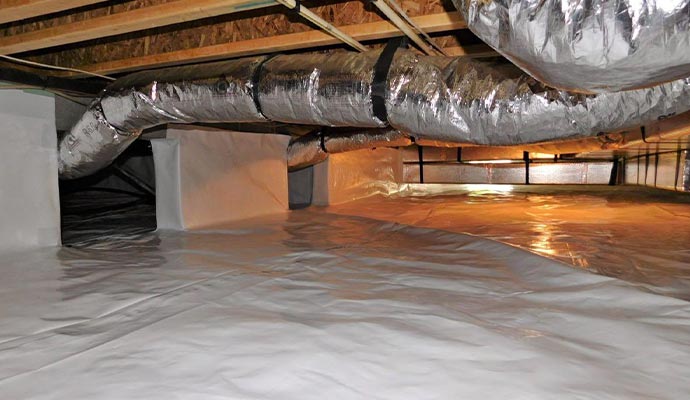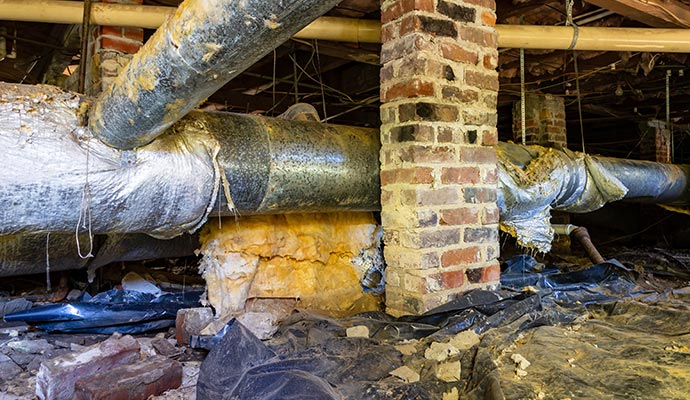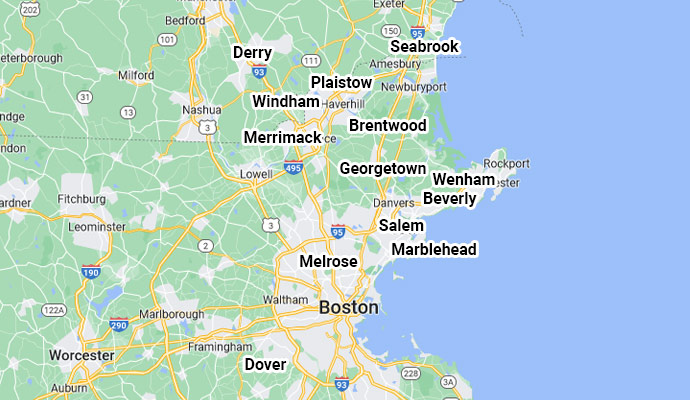What Causes Mold in Crawlspace?

Your home's crawlspace, often an overlooked area, has the potential to serve multiple functions to enhance its livability. Unfortunately, it can also become a breeding ground for trouble, mainly due to mold. Unsurprisingly, the crawlspace is a common location for mold growth.
Understanding the underlying causes of mold in the crawlspace is crucial to deal with the challenges posed by these microorganisms effectively. In this comprehensive guide, we will explore the various factors contributing to mold growth in the crawlspace and provide practical recommendations for successfully eradicating it. Below, we will examine some of the main culprits responsible for mold growth in your crawlspace:
- Moisture: Mold thrives in damp environments. Moisture in crawlspaces can come from various sources, such as groundwater, rainwater, plumbing leaks, or condensation.
- Humidity: High humidity levels can contribute to mold growth. Poorly ventilated crawlspaces trap humid air and create an ideal environment for mold.
- Poor Ventilation: Without adequate airflow, moisture can accumulate in crawlspaces, providing the perfect conditions for mold growth.
- Organic Material: Mold feeds on organic materials such as wood, paper, and insulation. Crawlspaces often contain these materials, which can serve as a food source for mold.
- Vapor Barrier Issues: A missing or damaged vapor barrier can allow moisture from the ground to penetrate the crawlspace.
- Temperature: Mold growth is more likely in warm temperatures, typically between 60-80°F (15-27°C). Crawlspaces can become warm during certain seasons, promoting mold growth.
- Flooding: If a crawlspace experiences flooding from a plumbing issue or natural disaster, the residual water can lead to mold growth if not properly dried.
- Inadequate Insulation: Lack of proper insulation can lead to temperature variations that cause condensation and moisture buildup.
- Groundwater Seepage: Water can seep into crawlspaces from the ground if the area is not sealed correctly or the home is built on poorly draining soil.
How Molds Grow and Spread

Mold in the crawlspace can be attributed to one primary factor: moisture. There are various ways in which excessive humidity can accumulate in this lower area. This creates an environment conducive to the growth of bacteria and mold and attractive to other pests, such as rodents and insects. Possible contributors to excess moisture in the crawlspace include plumbing leaks and other issues with water management systems. Damp crawlspace insulation and bathroom leaks can also contribute to elevated humidity levels. When the crawlspace lacks proper ventilation, humidity can quickly become trapped, exacerbating the moisture issue. All of these factors contribute significantly to the persistent dampness in the crawlspace. Mold begins as tiny spores in the air and on surfaces. These spores can germinate and develop into mold when they come into contact with a moist, nutrient-rich surface.
Mold spores are microscopic particles released into the air from mature mold colonies. Due to their lightweight nature, they can easily be dispersed by air currents, human and pet activities, and other means. These tiny spores can travel through the air and settle on surfaces far from the original mold colony. They can also enter buildings through open windows, doors, HVAC systems, and other openings. Once these spores land on a new surface, they can adhere to the material and remain dormant until conditions become favorable for germination and growth. The ideal conditions for mold spores to germinate and grow typically include moisture, warmth, and an organic food source. When mold spores encounter a suitable environment, they germinate and initiate the growth process, eventually establishing new mold colonies.
Types of Molds You Should Be Aware of
Typically, molds are divided into three categories: allergenic, pathogenic, and toxigenic. All three cause health issues, while the third is the most dangerous. The most common molds found in the home are
- Aspergillus (Powdery, can be white, green, or yellow)
- Penicillium (Blue or green with a velvety texture)
- Stachybotrys (Slimy, black or dark green)
- Alternaria (Dark green or brown, with a velvety texture)
- Fusarium (Pink, white, or reddish)
- Acremonium (Powdery, can be white, pink, gray, or orange)
- Ulocladium (Dark brown to black)
- Aureobasidium (Pink, black, or brown)
- Chaetomium (white and cottony, turning gray or brown)
- Cladosporium (Dark green, black, or brown)

Importance of Professional Mold Removal and Remediation
Mold should not be taken lightly as it's not simply a cosmetic issue on walls and ceilings. It consists of microorganisms that can lead to significant health concerns and structural damage. In addition to causing visual blemishes, mold can result in severe health problems and compromise the integrity of the building. Engaging in professional mold removal or remediation services is crucial to prevent potential health emergencies and hefty repair expenses. Attempting a do-it-yourself approach to mold removal can prove ineffective and may even exacerbate the extent of the damage.
Get Our First-class Mold Remediation Services in Portsmouth & Rye
For over two decades, Northeast Basement Solutions has proudly served various communities across New Hampshire and Massachusetts. As a locally owned and operated company, we take great pride in offering expert crawlspace services. Our dedicated team is committed to ensuring the safety and integrity of your crawlspace and home. Residents of Seabrook, Beverly, and Derry can rely on our specialized services. In addition to our exceptional workmanship, we provide comprehensive insurance support to our valued customers, giving you added peace of mind.
978-678-4080




